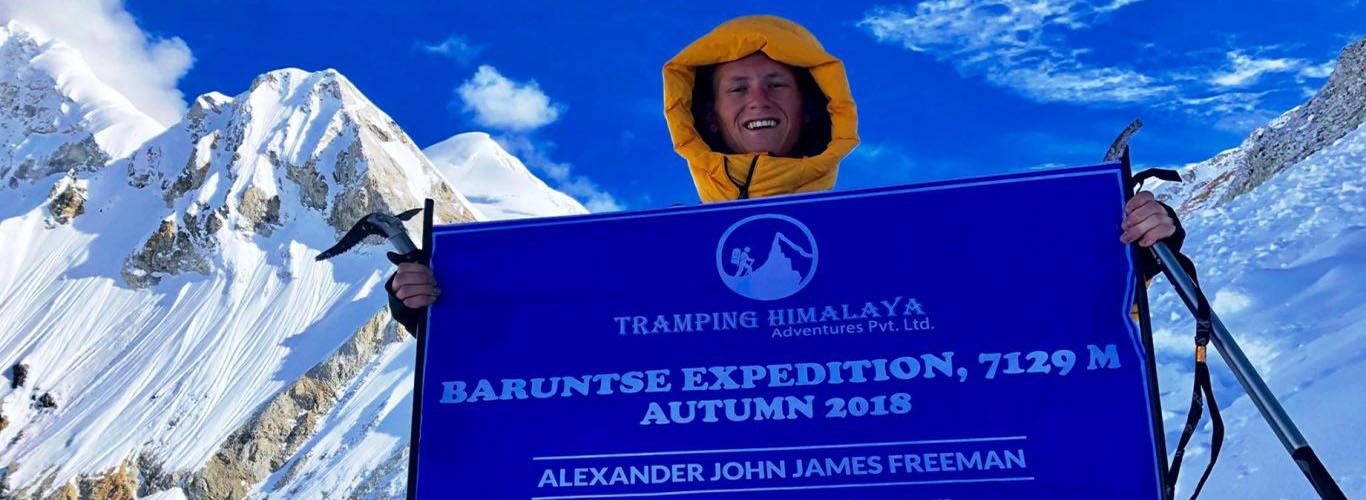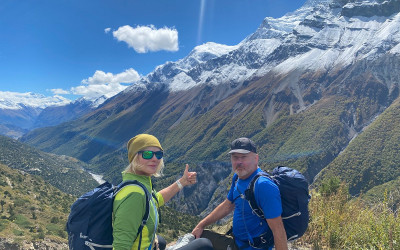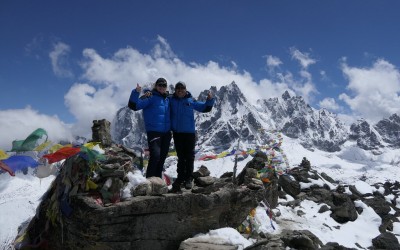Trip At Glance
-
Group Size2-15 Persons
-
Max Elevation7129 Meters
-
GradeFull Fledge Mountaineering Climbing Classification.
-
DestinationNepal
-
TransportationPrivate Car/Bus and Flight
-
AccommodationHotel/Guest house/Camping
-
CostContact Us
-
Trip Length38 days
-
Best MonthMarch to June & September/October
-
WIFIAvalable only first few days,
-
RegionExpedition
-
Trip ModeTrekking & Climbing
-
MealB/L/D
-
Trekking StyleTea House and Camping
overview
Trip Overview
‘trek and climb on remote and isolated areas of Khumbu to Mera Peak within scenic Inkhu valley’
Tramping Himalaya Adventures presents stunning adventure Mt. Baruntse Expeditions on the hidden corners east of Khumbu and west from Makalu areas towards south of Mt. Everest, a great walk and climb within pristine wilderness away from mainstream trekking trails of Everest. Mt. Baruntse Expeditions leads you on top above 7,129 meters high with sweeping panorama of world highest mountains from Mt. Everest, Lhotse, and Makalu as far towards Mt. Kanchenjunga in the eastern horizon with array of smaller peaks above 6,000 m.
Mt. Baruntse although below 8,000 m peaks, but the climb leads to tough efforts to reach its summit top truly a technical mountain to tackle where we have allocated maximum of twenty days for the climb as per the nature of the peak technical side. Mt. Baruntse Expeditions with 27 52 19 Latitude & 86 58 55 Longitude, a mountain of full scale Mountaineering Classification requires climbers with much experience on ice and rocks climbing to conquer the summit of Mt. Baruntse.
Mt. Baruntse Expeditions begins with an adventure taking a scenic short flight from Kathmandu to reach at Lukla within Khumbu areas of Everest, a busy town with its unique airstrip where most of the adventure and treks starts and ends at Lukla. Our journey continues away from Lukla leaving the main trail of Everest heading towards complete wilderness of natural surrounding within dense forest covered by rhododendron-magnolia-oaks-pines and fir trees with wonderful summer pastures and green meadows to pitch camps. Leaving the Lukla area and Chutanga forested areas heading for a climb to a high rocky ridge of Naulekh and Kalo Himal facing tremendous scenery of landscapes and snow clad peaks to reach at hidden areas within Inku valley closed in alpine woodland around Thuli-Kharka and Tagnag small temporary settlements.
Trek finally heads towards our main destination at Baruntse base camp after walking past the route of Mera Peak on leaving the rich green vegetation and tree lines for arid and barren terrain of arctic landscapes and cold temperatures. Walk leads to scenic areas of Hongu valley around smaller glacial ponds called Panch Pokhari where our trail heads further east to camp beneath the towering Mt. Baruntse, here with time for practice climb and ample acclimatization days before the Big Day to conquer the summit Mt. Baruntse. Within twenty days busy loading gears and ferrying to respective high camps where our leader and head climbing guide will fix the right day for the ascent as weather permitting with clear fine day to reach the summit with fabulous views of snow capped peaks. After a successful climb and triumph on top Mt. Baruntse heading back to Lukla using the same scenic route for flight to Kathmandu with outmost memorable adventure of a lifetime experience on Mt. Baruntse Expedition with strong support of Tramping Himalaya Adventures and its expert guides and staff.
Trip at a Glance
Trip Mode: Hotel – Lodge and camping from Lukla onward.
Trekking Grade: Adventurous and Challenging (on snow conditions).
Climbing Grade: Full Fledge Mountaineering Expeditions Classification
Trekking Region: Nepal Far Mid East Himalaya around East of Khumbu region
People & Culture: Sherpa tribes of Buddhism religion with interesting old traditions and colorful cultures.
Expeditions Durations: 34 Nights & 35 Days (Lukla to Lukla).
Total Expeditions: 39 Nights & 40 Days (Kathmandu to Kathmandu)
Seasons: March to early June and September to October months March to May flowering times on hills, September and October clear days with blue sky (with cold morning and nights with chances of snow)
HIGHLIGHTS
Highlights of Mt. Baruntse Expedition
- Scenic flights to and from Lukla with views of Everest and array of peaks during scenic air borne
- Adventure around least trekked and explored areas by other trekkers within complete wilderness
- Explore the hidden eastern Khumbu and South of Everest areas near to Makalu and Barun region
- Enchanting pristine forest filled with tall rhododendron-magnolia-pines-oaks and fir trees
- Marvelous walks within beautiful and scenic Inkhu and Hongu valley for the climb on top Mt. Baruntse
- Adventure from green woodland to arid region of arctic zone within ice, moraine and glaciers
ITINERARY
Detailed Itinerary
Cost Included
- Airport Pick up & Drop with private transport
- Hotel in Kathmandu 5 Nights 3-star standard with B/B ( Norbulinka Boutique Hotel or Similar )
- Flights and transfer Kathmandu-Manthali-Lukla-Kathmandu
- Mt. Baruntse Expedition permit ( Royalty: USD 500 for Member )
- Government Liason Officer for Baruntse Expedition
- Khumbu Pasang Lhamu Gaupalika entrance fee & Baruntse National Park Entry permit and Tims Card
- All Camping equipment in Advance Base Camp and other Camps
- Food, Accommodation, and guide during the trekking in teahouse/lodges
- Food during the expedition period cook by our experienced cook at Amadablam Base Camp, C-1 and C-2
- 1:1 Experienced personal Climbing Guide for Climbing Support
- Baggage allowance carrying by porters up to 40 Kg up and down to Base Camp
- Required high-altitude food for members and Sherpa
- Required fixed and dynamic ropes for climbing gy Sherpa Guide
- Insurance, Wages, meal,s and allowances for climbing sherpa and Base Camp Staffs
- Solar panels for light and battery charging in Base Camp
- Icefall and rope fixing charges, At high camps C-1, C-2, and C-3
- First aid medical kits for the Group and the Staffs
- Walkie-talkies & satellite phones for communications ( with a charge per minute of USD 5 )
- Office changes and Government Taxes Levied in Nepal
Cost Excluded
- Nepalese visa fee ( Bring the right cash in USD and 2 passport-size photographs )
- 15 Days USD 30, 30 Days USD 50, 90 Days USD 125,
- Airfare International and domestic flights other than specified
- Lunch and dinner during your stay in Kathmandu Except for farewell dinner in Kathmandu
- Clothing, Packing items, Personal Medical Kit, Personal trekking/climbing gears
- Items of a personal nature like phone calls and like laundry and internet use,
- Any extra services or products or offers or activities not mentioned in the Itinerary
- Any additional staff (s) especially required by the climbing member
- Rescue, repatriation, medicines, medical tests and hospitalization expenses
- Medical travel insurance and emergency rescue evacuation if required
- Any extra expenses arising out of various/unforeseen situations like natural calamities, landslides, political disturbances, Strikes, Changes in Government regulations etc,
- Nepal custom duty fees for import or expedition goods if required
- Summit bonus to the personal climbing Sherpa ( Beginning from a minimum of USD 700 per Summit per Sherpa)
- Tips for Base Camp Staffs per climbing member from a minimum of USD150 in total for all the staff
- Any other item not mentioned in the service package exclude section,
Information
Some Additional Information
Fixed Departure
| SN | Start Date | Trip Duration | Cost Per Person | Availability | Join Group |
|---|---|---|---|---|---|
| 1 | 2024-10-05 | 38 Days | USD 9000 | Available | Book Now |
















